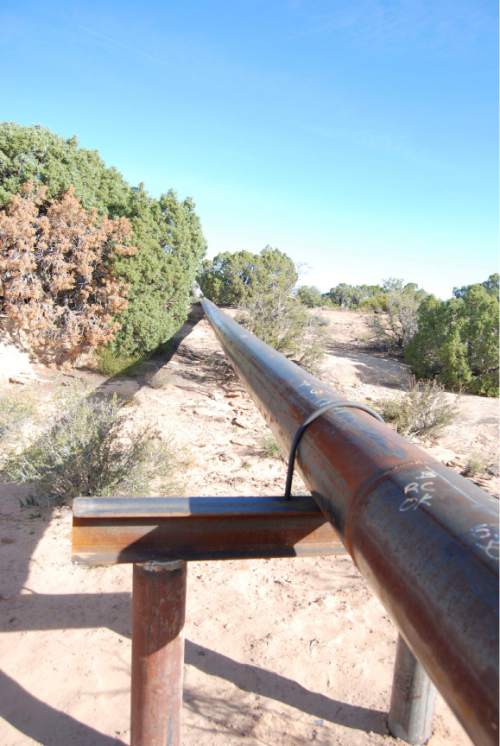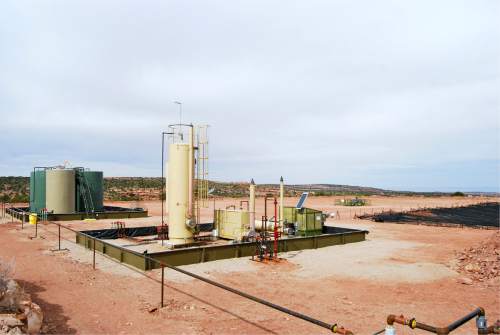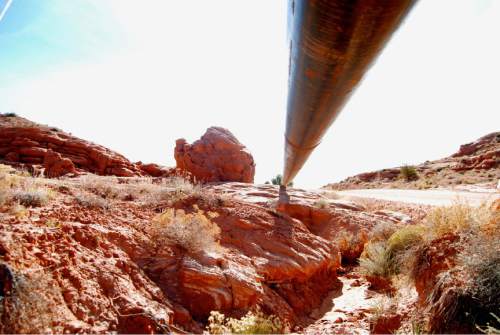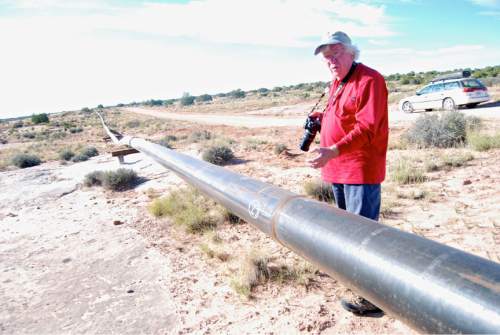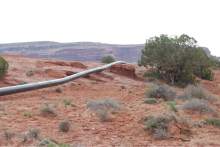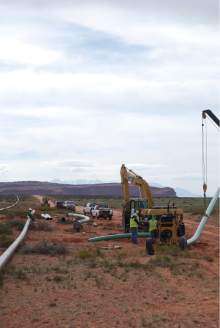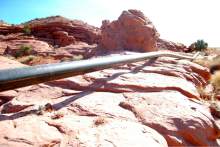This is an archived article that was published on sltrib.com in 2014, and information in the article may be outdated. It is provided only for personal research purposes and may not be reprinted.
Moab • An interesting thing happened after Fidelity Exploration and Production Co. started drilling near the entrance to Dead Horse Point State Park.
Cane Creek Well 12-1 let loose.
Without the aid of pumps or fracking, the oil just flooded out — more than 600,000 barrels in its first year, making it the nation's most productive on-shore well in 2012.
The hydrocarbon bounty, however, includes unexpectedly large amounts of methane and other components of natural gas that Fidelity has to burn off because there is no way to get those fuels to market.
To solve its delivery problem, the company proposes an intensive network of pipelines that is fueling a backlash among red-rock recreationists and preservationists alike.
Well 12-1 sits in Big Flat, an area 15 miles west of Moab near Highway 313. About 500,000 visitors drive through each year to Dead Horse Point and Canyonlands National Park's north entrance into Island in the Sky. It's still a lovely place to hike and ride.
But some Moab residents and businesses worry that all will change if Fidelity's pipeline project is completed, clearing the way for another 50 wells to be drilled.
"We have these iconic scenic lands that belong to all Americans and they are in conflict with what the mineral extraction industry is calling a major play," says Moab resident Marc Thomas, an active member in the Sierra Club's Utah chapter.
Finally a profit
Drilling on Big Flat dates back to 1962, but it was only after Fidelity took over the 53,474-acre Cane Creek unit in 2007 that the wells tapping the Paradox Basin formation became a commercial success.
The company is now the largest producer in southeastern Utah, with operations on three additional plots in San Juan County.
To capture and sell the gases from Big Flat, the company has built a 25-mile above-ground "lateral" pipeline and plans to construct a 26-mile network of gathering lines to deliver the gas to a new processing plant near the Canyonlands Field airport, then east to a major transmission line.
The new network, which could take up to five months to complete and will be almost entirely underground, will tie the unit's 19 well pads to the lateral line completed this year.
Many see the oil pad as an economic boon for the county.
The BLM analysis, for example, predicts Fidelity will drill another 52 wells on Big Flat, yielding enough gas to make the county $52 million over the field's 30-year life. That's on top of the 3,500 barrels of oil it is currently producing.
The $70 million pipeline project may not yield much of a return for the company, but it will ultimately reduce Fidelity's environmental footprint, according to environmental manager Mike Keller.
Keller emphasizes that Cane Creek remains an exploratory asset. A financial justification for building the gas line didn't come up until the flaring issue in 2012.
Fidelity uses high-efficiency combusters that ensure more than 98 percent of the escaping methane burns.
The company cannot simply slow production without risking damage to the wells, he said.
Changing economy
While Fidelity's Big Flat oil field may be puny compared with the drilling bonanza in the Uinta Basin, it represents a "visible harbinger" of what's to come in Grand County, Thomas says. Tourism and recreation have become the region's economic salvation, he added. But pressure to develop oil and gas is building.
"The greater Canyonlands sits on the Paradox Basin which is a big play for oil and potash," Thomas said.
Many view the busy Cane Creek oil patch as part of a larger trend toward the "industrialization" of Moab's canyon country at the expense of tourism, which supports 70 percent of the county's employment.
Big Flat's 25 wells are within BLM's 300,650-acre Labyrinth Rims/Gemini Bridges special recreation management area, used by at least 35 permitted outfitters.
And some worry about the future of their businesses.
"The trail consumer is discerning. It's competitive. A lot of communities want to eat Moab's lunch," said Ashley Korenblat, owner of Western Spirit Cycling and a spokeswoman for the Utah Outdoor Business Network.
"If we don't provide the experience people expect and it's degraded by traffic and noise, we are going to lose customers."
A wasted resource
The Utah Division of Oil, Gas and Mining has insisted Fidelity pipe the gas coming off the Cane Creek unit.
Last year, the field torched 456,000 cubic feet, or Mcf, releasing greenhouse emissions and wasting a resource that could generate revenue to both state and federal governments. An Mcf is the standard sales unit for natural gas and currently fetches $4.83 on the spot market, so last year's flared gas was worth about $2.2 million.
Utah oil and gas fields flared or vented 2.6 million Mcf, according to DOGM spokesman Jim Springer.
DOGM allows operators to flare and vent up to 1,800 Mcf per month per well without seeking approval. Some of Fidelity's wells have exceeded that regulatory limit and the Oil, Gas and Mining Board has granted extensions to Cane Creek to give the company through the end of this year to come into compliance.
Fidelity expects to return to the board seeking another extension because it will not be able complete the gathering network on time.
But many fear the lateral and gatherings pipelines are being built on the cheap and without adequate oversight.
The lateral pipeline, a 12-inch-diameter steel tube, stretches on the ground along roads, except where it dives under the dusty thoroughfares.
During a tour of the line this week, Castle Valley resident Bill Rau pushed down on a section that spanned a wash, crossing 80 feet of air without a single support. The pipe bobbed for a minute.
Rau imagines the impact of a monsoonal rush.
"The unexpected can easily happen if you get a really intense downpour and a flash flood that is going to carry a lot of rock smashing into this pipeline," said Rau, a retiree who moved to Utah two years ago and has become active in environmental debates.
"It could rupture. We have had many assurances from pipeline companies that all is well," he said. "Yet every 36 hours, an incident occurs in this country."
It's only a matter of time before an ATV rider attempts to drive over the line or a drunken teen tries to walk on it, Rau figures. Building the line to high transmission standards and putting it underground would prevent accidents, he and others have argued.
But the company maintains the trenching required to bury the lateral pipeline would multiply the project's impacts and clear a corridor 75 to 100 feet wide. And, Keller says, its design parameters are more than adequate to meet its demands given the low pressures required to move the gas.
"The line is overbuilt for its function," he said. "The wall thickness is more than it needs to be."
The lateral pipeline ends at a new processing plant that will remove water and liquid fuels from the gas. It can handle up to 5,000 Mcf a day, but it is designed so that its capacity can be doubled if needed, according to Keller.
Meantime, environmental groups are frustrated with the BLM for not reviewing the Cane Creek activities as a package of interdependent projects.
For example, BLM conducted separate Environmental Assessments for Fidelity's lateral line and for its gathering-line network. Earlier this month, BLM field manager Beth Ransel signed off on the gathering project after that assessment determined it would result in "no significant impact."
"The system does not protect the public and Big Flat is a good example of that," said Scott Groene, executive director of the Southern Utah Wilderness Alliance. "It has always been segmenting the impacts from each other. The agency says, 'We don't know what's going to happen, so why study those impacts now?'"


